
Edward Winter

The chess world has lost one of its most entertaining writers: Irving Chernev died on 29 September 1981 at the age of 81. That there is no common agreement on which was his finest book is an indication of the high quality of his overall output. The Chess Companion, The Most Instructive Games of Chess Ever Played, Logical Chess Move by Move and Capablanca’s Best Chess Endings are all works of exceptional erudition and value as well as of humour and warmth. He claimed that he simply read about chess for pleasure, subconsciously doing research, but no amount of charm and wit in his writings could conceal his deep-rooted knowledge and understanding of chess play. Logical Chess Move by Move includes his beautiful win against Hahlbohm at New York, 1942.
(46)
Jeremy Gaige’s Chess Personalia (Jefferson, 1987) states that Irving Chernev was born on 29 January 1900 in Priluki (Ukraine), but we note that at the familysearch.org website the birth-date 17 June 1899 is indicated.
‘January 1900’ was given on page 7 of Chernev’s last (posthumous) book, 200 Brilliant Endgames (New York, 1989), i.e. in an affectionate introduction by the book’s editor Adam Hart-Davis, who met Chernev a number of times. Mr Hart-Davis has now informed us:
‘I do recall Irving saying that he could always remember how old he was because he was born in January 1900, and therefore was as old as the current year.’
(3007)
A letter from Irving Chernev’s grandson, Melvin, to Andrew Soltis was published on page 6 of Chess Life, October 2018, written on behalf of his father, also named Melvin, and co-signed by Celia Ann Chernev. From the first paragraph:
‘As you stated, Mr Chernev was born in 1900 in the Ukraine, and he came to Brooklyn, New York in 1905 with his parents and siblings.’
According to page 4 Chernev’s Wonders and Curiosities of Chess, Grünfeld played 1 e4 only once in his tournament career (and match?), against Capablanca at Carlsbad, 1929. On page 18 of the same book it is claimed that Chigorin played 1 d4 only once, against Albin at Nuremberg, 1896. True or false?
(819)
John Gray (Townsville, Australia) and Michael McDowell (Newtownards, Northern Ireland) point out that the Chigorin claim is false: he played 1 d4 twice at London, 1883, against Mackenzie and Bird. Mr Gray informs us that I. Romanov’s study (Moscow, 1960) attributes the incorrect claim to N. Grekov’s M.I. Chigorin.
(864)
A pointless yarn, often repeated (e.g. Chernev’s The Bright Side of Chess, page 19), is that at Nottingham, 1936 Salo Flohr thought he would win all the prizes because he heard the lift operator say ‘First Flohr, Second Flohr, Third Flohr’.
Before the story is printed yet again, it would be as well to mention that it had already been given in CHESS for 14 November 1935 (page 115), where the witticism is credited to Lilienthal. Since the writer of the article in question is George Koltanowski, one must be doubly sceptical.
(887)
Irving Chernev wrote on page 40 of Curious Chess Facts (published in 1937):
‘The Cambridge Springs Tournament took place in 1904. The Book of the Tournament was published in 1935, 31 years later!!’
The May-June 1937 American Chess Bulletin (page 51) pointed out that Chernev ...
‘... ignores not only the complete set printed in the initial number of the American Chess Bulletin for June 1904 but the original publication, day by day, in the Bulletin of the tournament from the Rider Press in Cambridge Springs, issued to subscribers.’
Chernev nevertheless repeated his paragraph word for word on page 42 of Wonders and Curiosities of Chess (published in 1974). At least he removed one of the exclamation marks.
(1550)
From C.D. Robinson (Toronto, Canada):
‘Let us be fair to Mr Chernev: he is quite accurate. He refers to the book of the tournament, and this must necessarily be a monograph. The daily bulletins issued while the tournament was being played and the publication of scores (or whatever; the quotation is not specific) in the American Chess Bulletin are examples of serial publication. Would you describe an account of a tournament, which appears in Chess Life or the BCM, as “the book of the tournament”?’
We consider that C.N. 1491 (pages 116-117) reviewed two Brussels 1987 tournament books, a term commonly used when a special issue of a journal (New in Chess in that case) gives all games. See also, for instance, the title ‘A Hastings Tournament Book’ on the front cover of the January 1977 CHESS.
(1634)
From page 325 of The Golden Dozen by Irving Chernev (Oxford, 1976):
‘Eugene Alexandrovich Znosko-Borovsky (a resonant name if ever there was one) once published a monograph called “Capablanca’s Mistakes”. Capablanca’s response to this was to tell the author that he had tried to write a work called “Znosko-Borovsky’s Good Moves”, but had to give it up as he could not find enough material.’
(1562)
For many other fact-free versions of this story, see Chess Anecdotes.
From an interview given by Irving Chernev on pages 500-503 of Chess Life & Review, September 1979:
‘I have probably read more about chess and played over more games than any man in history.’
A similar claim appears in a newspaper interview being circulated by James Schroeder (no exact source given). J.S. divulges:
‘I know more about chess than anybody that ever lived. I'm world famous in Cleveland, Ohio.’
(Kingpin, 1996 and 1998)
‘Dr Bernstein is a famous master; his fame rests on three atrociously played games with Capablanca. That this great player deserves more than merely negative immortality is realized by very few people. Tartakower points out the interesting fact that Bernstein, in common with Rubinstein, Nimzowitsch and Spielmann, was among the first to rebel against the artificial stiffness and formalism of the Tarrasch epoch.’
Source: Page 36 of Chess Strategy and Tactics by F. Reinfeld and I. Chernev (New York, 1933).
(2692)
A Chess Omnibus had this footnote on page 308:
Another straightforward example of K. Whyld’s propensity for distortion and untruth is his assertion (Kingpin, Summer 1997, page 61) that on page 264 of Chess Explorations we ‘savaged’ Irving Chernev over a Lasker/Capablanca matter. The public record is 100% clear there too. As regards Whyld’s conduct regarding F.M. Edge (see pages 245-260 of A Chess Omnibus), at the Chess Café on 1 August 2000 we quoted a number of Frank Skoff’s apposite observations about Whyld, from a communication to C.N. dated 17 November 1989. Among the milder ones were: ‘He thinks calling people names (including myself) somehow is proof by itself’ and ‘It is astonishing how little value K.W. places on truth: He prefers its suppression at any cost. Why?’
Below is the complete passage on page 264 of Chess Explorations:
C.N. 564 quoted from pages 38-39 of Chernev’s Wonders and Curiosities of Chess:
‘A strange disaster occurred to Lasker and Capablanca in 1934. Alekhine beat Lasker at Zurich in 26 moves, sacrificing his queen to do so; Lilienthal beat Capablanca at Hastings in 26 moves, sacrificing his queen to do so!’
Alas, the Lilienthal-Capablanca game was played on 1 January 1935.
Would anyone other than K. Whyld suggest that the above passage ‘savaged’ Irving Chernev?
A feature article about K. Whyld is Reliability Eroded.
On page 36 of his book Curious Chess Facts (New York, 1937) Chernev questioned Alekhine’s analysis of game 40 in My Best Games of Chess 1908-1923. It was his second match-game against Levitzky in St Petersburg, 1913, and Alekhine (White) began 1 e4 e5 2 f4 exf4 3 Bc4 Nf6 4 Nc3 Bb4 5 Nge2 d5 6 exd5 f3 7 gxf3 O-O 8 d4 Bh3.
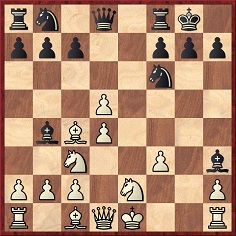
Here Alekhine played 9 Bg5 and commented:
‘The plausible move was 9 Nf4, protecting both pawns and attacking the bishop, but upon this Black had the following win in view: 9…Re8+ 10 Kf2 Ng4+! (seemingly inoffensive because of White’s reply) 11 Kg3 Nf2!!, etc. With the text-move White definitely assumes the initiative.’
Chernev stated that in this line, ‘Actually, White can win by replying 12 Qg1!!’ Whether or not White’s advantage is decisive, it certainly seems that he has the better game and that, therefore, Alekhine’s analysis was faulty.
(3093)
Irving Chernev’s final (posthumous) book 200 Brilliant Endgames (New York, 1989) was reprinted by Dover Publications, Inc. in 2003. When the original appeared, C.N. 1928 pointed out, ‘a number of diagrams and solutions starting on page 182 are out of sync’. The fault remains in the Dover edition.
(3166)
Following the publication of two game positions in the December 1999 Chess Life we wrote to the magazine:
‘If “Evans on Chess” is to lift work from my Chess Notes (i.e. the Borochow and Junge items in the December 1999 Chess Life) would it not at least be possible for that to be specified and for the material to be used accurately?’
This complaint, published in the correspondence column of the February 2000 Chess Life, was straightforward: his December 1999 column had included two positions (from the games Borochow v Fine, Pasadena, 1932 and N.N. v O. Junge, Concepción, circa1909) taken, a reader in the Philippines said, from ‘our local magazine Chess Asia’. The fact that they were culled from Chess Notes (which, at that time, Chess Asia was still publishing) was given no mention whatsoever.
One of the two positions discussed above deserves a separate section here. The famous miniature between Borochow and Fine at Pasadena, 1932 is yet another example of how facts in Evans’ hands stand no chance. This is shown by C.N. 1968, in which we wrote:
‘According to a number of books, the late Reuben Fine once lost a tournament game in seven moves. The score of H. Borochow v Reuben Fine, Pasadena, 1932 is often said to be: 1 e4 Nf6 2 e5 Nd5 3 c4 Nb6 4 d4 Nc6 5 d5 Nxe5 6 c5 Nbc4 7 f4 Resigns.
Page 436 of the August 1978 Chess Life & Review published a letter from G.S.G. Patterson, the President of the Pasadena, 1932 International Chess Congress, reporting that the actual moves were: 1 e4 Nf6 2 e5 Nd5 3 d4 Nc6 4 c4 Nb6 5 d5 Nxe5 6 c5 Nbc4 7 f4 e6 8 Qd4 Qh4+ 9 g3 Qh6 10 Nc3 exd5 11 fxe5 Resigns.
Patterson’s letter specifically corrected Larry Evans, who had affirmed (Chess Life & Review, October 1977, page 557) that Fine won the game. Even so, in a book published several years later – The Chess Beat – Mr Evans repeated, in large bold letters, his claim that “Black won” (after 7 f4 e6), adding “But Chernev says Black resigned!” (page 24). For our part, we see no reason to doubt G.S.G. Patterson’s version of the score. Mr Evans’ unaccountable assertion that Fine won is refuted by the tournament crosstable.’
This text was reproduced on pages 314-315 of Kings, Commoners and Knaves, together with C.N. 2084. That latter item (which was the basis of what appeared in Evans’ December 1999 column) reported on the researches by a correspondent of ours, Val Zemitis. Mr Zemitis also had a brief note published in Evans’ May 2000 column, in which he expressed the belief that the game had indeed lasted eleven moves ‘instead of the seven as cited by Irving Chernev’. The intriguing point here is Evans’ rejoinder: ‘You can’t take all of Chernev’s “facts” too seriously.’
Unlike Evans’ ‘facts’, perhaps? Chernev had indeed been wrong (in a book published back in the mid-1950s) to give a seven-move version of the game, but at least he had correctly stated that it was White who won. Question: which author claimed in 1977 that it was Black who won? Answer: Evans. Question: which author was publicly corrected on this point in 1978? Answer: Evans. Question: which author nonetheless maintained in a 1982 book that Black won? Answer: Evans. Question: which author scoffed at that time, ‘But Chernev says Black resigned!’? Answer: Evans. Question: which author nonetheless has the gall to criticize Chernev for inaccuracy regarding this game? Answer: Evans.
See also The Facts about Larry Evans.
From page 158 of CHESS, April 1940 (in a review of Reinfeld’s book Practical End-Game Play):
‘Mr Reinfeld is an attractive and industrious writer but there are certain faults of which he must rid himself to become a great one. It is in all kindness that we enumerate them. The first is bumptiousness. He is too prone to throw his weight about from the safe retreat of armchair analysis. The amateur reader, hearing him denounce Tarrasch for “gross blunders”, Schlechter for “superficial appraising of the position”, Euwe for “grossly miscalculating”, Tartakower for “lack of insight” and so forth can hardly fail to ask, with initial admiration: “Who is this genius who can pierce through the armour of the great?” Mr Reinfeld’s playing record comes as a shock. The discovery of occasional “gross errors” in his writings, committed not under the nervous tension of tournament play but in the calm of literary composition and overlooked in successive proof-corrections and the realization that the analysis on which he bases his denunciations is rarely his own (as his own meticulous acknowledgments reveal) add to the disillusionment. Such a disillusionment is unnecessary and pointless. We judge a writer as a writer, a player as a player – until the writer obtrudes his own personality on us by such harsh and pointless criticisms.’
This passage brings to mind criticism of Tarrasch by Irving Chernev, on the inside front cover of the January 1956 Chess Review:
‘Mistakes? Rarely did he make one. But here he pulls a boner that is surely the grandmother of all the blunders ever perpetrated on a chessboard.
List to this tale of woe:
It was in the days of his youth, when all the world was still playing wild gambits. Tarrasch had given a piece for a speculative attack, and his opponent was having a rough time of it. The position had been simplified by an exchange of queens, but the defense was still in trouble. Then, to add to the confusion, Tarrasch sacrificed a bishop. In return, he threatened a tremendous discovered check. It was just a matter of moving his knight to the right square.
But now comes a strange spectacle: that of the great master floundering around, trying to [find] the one discovered check which wins. Tarrasch missed the right idea – not once, but four times in succession. His knight hopped about from square to square and when, at long last, Tarrasch succeeded in winning the game it was with the wrong discovered check.’
The game-score was then given:
Siegbert Tarrasch – Hermann Hirschler1 e4 e5 2 f4 exf4 3 Nf3 g5 4 h4 g4 5 Ne5 d6 6 Nxf7 Kxf7 7 Bc4+ Kg6 8 d4 Be7 9 Bxf4 Nf6 10 h5+ Kg7 11 Nc3 Nc6 12 e5 dxe5 13 h6+ Kf8 14 dxe5 Qxd1+ 15 Rxd1 Nd7 16 O-O Ke8 17 Nd5 Bc5+ 18 Kh1 Bb6 19 e6 Nde5 20 Nf6+ Ke7 21 Bg5 Nxc4
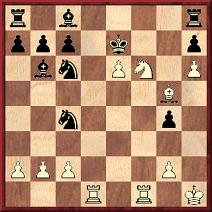
(Chernev: ‘At this point Tarrasch has a win. He pointed it out clearly and concisely long after the game was played [i.e. mate in four with 22 Nh5+]. Tarrasch did not admit that he overlooked the win. Instead, he said that he wanted to confuse his opponent psychologically. He would demonstrate by several knight maneuvers that Black dare not capture the e-pawn and then, when he was thoroughly convinced, Tarrasch would swindle him, playing a variation in which Black must take the pawn to save himself – but is too scared to do so.’) 22 Nxg4+ Ke8 23 Nf6+ Ke7 24 Nd5+ Ke8 25 Nf6+ Ke7 26 Nd7+ Ke8 27 Nf6+ Ke7 28 Ng8+ Ke8 (Chernev: ‘And here indeed Black can save himself by taking the pawn: White has no plausible, winning line.’) 29 Rd8+ Nxd8 30 Rf8+ Kxf8 31 e7+ Resigns.
Chernev’s annotations were based on Tarrasch’s own remarks on pages 391-392 of Dreihundert Schachpartien (Gouda, 1925). See also pages 340-341 of Tarrasch’s Best Games of Chess by F. Reinfeld (London, 1947).
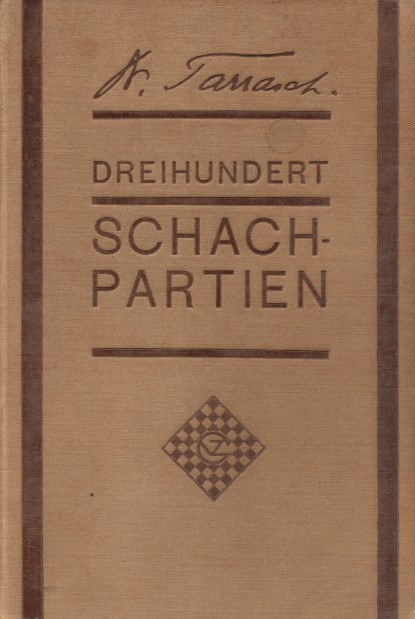
Whether the game was more than an offhand encounter is unclear, but it seems to us a sizeable exaggeration by Chernev to accuse Tarrasch of perpetrating ‘a boner that is surely the grandmother of all the blunders ever perpetrated on a chessboard’.
As regards the occasion, Chernev, who put ‘Nuremberg, 1894’, said that the game was won by Tarrasch ‘in the days of his youth’, whereas he was about 32 at the time. Some databases unaccountably state that the game was played in Berlin in 1880.
(3829)
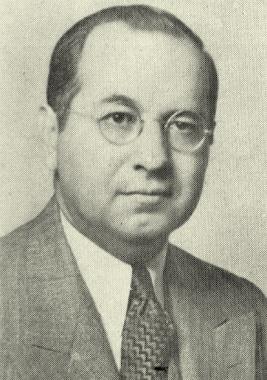
Irving Chernev
Chernev gave ‘some personal opinions’ on page 28 of the November-December 1933 Chess Review. They included the following:
- ‘The perfect game is Réti-Kostić, Teplitz, 1922.
- The most important game. Pillsbury-Tarrasch, Hastings, 1895.
- The most exhaustive – and exhausting – annotator is Tartakower.
- The laziest. Lasker and Teichmann.
- The most interesting matches were Alekhine-Bogoljubow, 1929, Tarrasch-Schlechter, 1911, and Capablanca-Euwe, 1931.
- The most interesting combinative game was Alekhine-Cohn, Stockholm, 1912.
- The coolest player under fire is Kashdan.
- The perfect annotators are Alekhine, Marco and Grünfeld.
- The game most interestingly annotated is Bernstein-Nimzowitsch, St Petersburg, 1914, by Marco in the Wiener Schachzeitung.
- The most brilliant move was move no. 36 R-Q5, in the game between Alekhine and Tartakower, Vienna, 1922.
- Perhaps the most overrated player was Morphy.
- The most underrated player was Teichmann.
- The greatest “natural” player was Zukertort.’
(5624)
Asked about chess books which had a profound influence on him, John Nunn replied (see the 3/2002 New in Chess, page 98):
‘When I was a young player, I read The Most Instructive Games of Chess Ever Played by Irving Chernev which made chess seem extremely easy. However, I then read Alekhine’s Best Games of Chess, which made chess seem impossibly difficult. I eventually discovered that the truth lies somewhere between the two.’
Dr Nunn informs us:
‘I was referring to the 1924-37 volume by Alekhine. I recall being particularly impressed by 18...Nxf2 in Rubinstein v Alekhine, Semmering, 1926, or rather the fact that Alekhine must have seen it some time in advance.’
Most C.N. items mentioning Irving Chernev have concerned chess history and lore, but he was an exceptionally entertaining annotator. The Most Instructive Games of Chess Ever Played was published by Simon and Schuster, New York in 1965 and by Faber and Faber, London the following year. The US publishers also brought out a Fireside paperback edition (undated), and in 1992 the work was reprinted by Dover Publications, Inc., New York. An algebraic version has yet to be produced and would be very welcome.
(8196)
C.N. 8196 discussed The Most Instructive Games of Chess Ever Played by Irving Chernev, a book which had a profound influence on John Nunn, and we commented: ‘An algebraic version has yet to be produced and would be very welcome.’
An algebraic edition has now been published, by Batsford (‘an imprint of Pavilion Books Company Limited’).
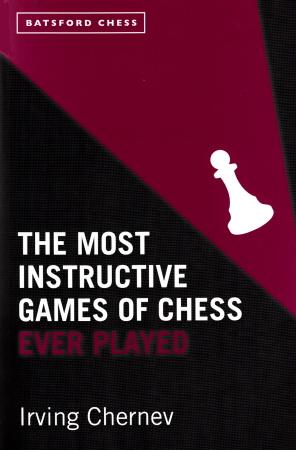
When it first appeared, in the mid-1960s, the book received extensive coverage in Chess Review, although not in Chess Life, and on page 39 of the February 1966 Chess Review an advertisement listed all 62 games selected by Chernev:
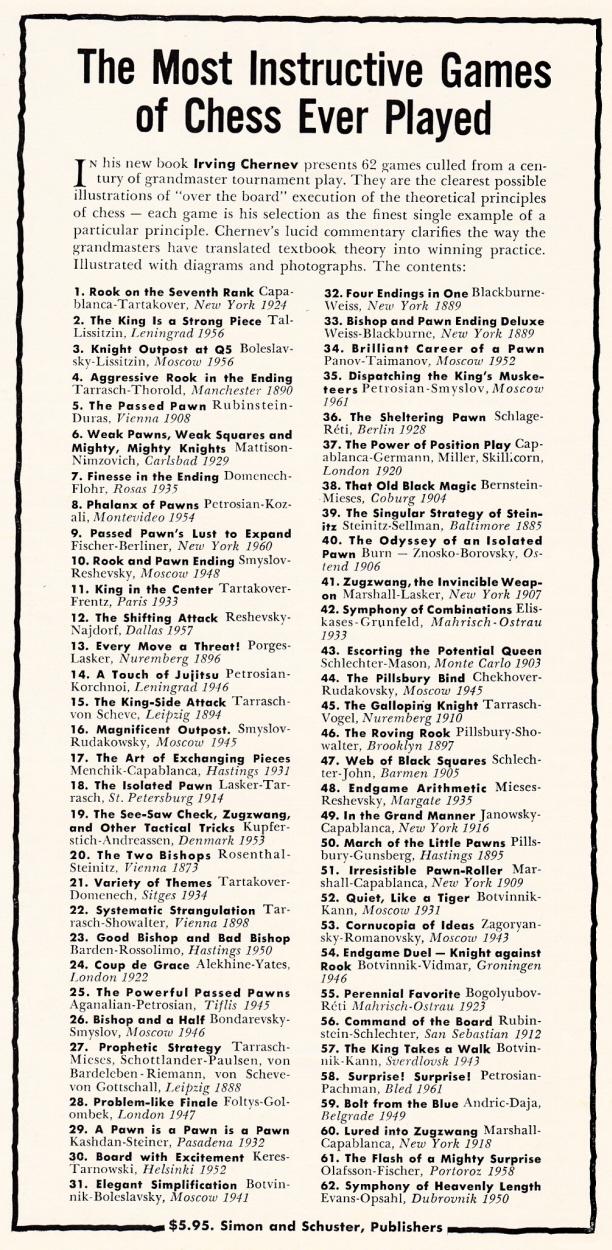
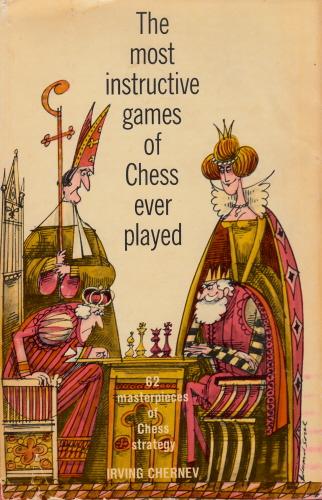
The February 1966 issue of Chess Review also had, on pages 46 and 64, a lengthy, highly favourable review by John W. Collins. As regards the production standards he observed:
‘Designed by Cecile Gutler [sic – Cutler], the physical aspects of the book are attractive. The cover design and frontispiece by Edward Sorel is one of the most original to appear. The binding is red and sturdy, the paper and type good ... and the photographs striking (these last are a welcome additive too many publishers omit for economy).’
All the photographs have been omitted from the Batsford edition. In common with other recent Batsford books (most notably, the 2008 edition of Fischer’s My 60 Memorable Games), the volume as a whole (a paperback, naturally) looks drab, despite some attempt to replicate the textual lay-out of the original.
‘Drab’ would never describe Chernev’s writing, and in The Most Instructive Games of Chess Ever Played he was perhaps at his best. Collins wrote:
‘... one feels this latest book is the true Chernev, one might say the ultimate Chernev. It gives full vent to his enthusiasm, wit, admiration of the positional-strategic and his encyclopedic knowledge of the Royal Game. Much of this is evident in his previous works, but this time it all comes out.’
This reference to Chernev’s qualities, and not least his knowledge, is certainly justified. Although C.N. items have shown that he sometimes cut corners, he was active at a time when writing and scholarship were not regarded as a natural pairing and when anecdotes and other chestnuts were particularly prevalent. Few were interested in sources. Above all, in the pre-digital age the work of writers in his field was far harder; they could not fill in gaps in their knowledge with press-of-a-button ‘research’.
Chernev’s output – clear, humorous and easy-going – gave the impression of effortlessness, but much industry lay behind it all. On 19 January 1977 he wrote to us:
‘I think you will be pleased to hear that I have sent off to Oxford University Press my completed manuscript of Capablanca’s Best Chess Endings, a labour of love (and hard work).’
Although his prose was often conversational, it was literate and carefully structured, bearing no resemblance to the ultra-casual ‘I’m-just-one-of-the-lads’ stuff increasingly seen in chess books and magazines since his time. We have also been struck by the scarcity of typographical errors in Chernev’s writing throughout his life.
Relatively few of his own games are readily available, although it is not difficult to find unknown or little-known scores. Two games from Section B of the preliminaries for the 1942 US championship, including the one below against Altman, were published on page 29 of the March-April 1942 American Chess Bulletin.
Irving Chernev – Benjamin Altman
New York, 1942
Queen’s Gambit Declined
1 d4 d5 2 Nf3 Nf6 3 c4 e6 4 Nc3 Be7 5 Bg5 h6 6 Bh4 Nbd7 7 e3 c6 8 Bd3 dxc4 9 Bxc4 Nb6 10 Bb3 Nbd5 11 O-O O-O 12 Rc1 Nxc3 13 bxc3 b6 14 Ne5 Bb7 15 Qd3 c5 16 f3 Bd6 17 Bc2 g6 18 Nxg6 c4 19 Qxc4 fxg6 20 Qxe6+ Kg7 21 e4 Qe7 22 Qh3 Bc8 23 g4 g5 24 Bf2 Bf4 25 Rcd1 Qa3 26 e5 Nd5 27 Be4 Ba6 28 Bxd5 Rad8 29 Bb3 h5 30 Rfe1 Rh8 31 Be3 Rdf8 32 Bxf4 Rxf4 33 gxh5 Bc8 34 e6 Qd6 35 Re5 Kf6 36 h6 Rh7 37 Qh5 Ke7 38 Qxg5+ Rf6 39 Rde1 b5 40 R1e4 Rhxh6 41 Qg7+ Ke8 42 Rg4 Bxe6 43 Bxe6 Rxe6
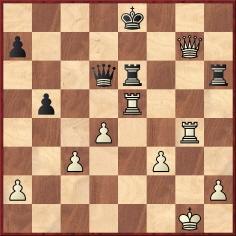
44 Qxh6 Qxe5 45 Qxe6+ Qxe6 46 Re4 Resigns.
In the other game on that page, Chernev’s opponent, D. Podhorcer, blundered early on: 1 d4 Nf6 2 Nf3 e6 3 c4 b6 4 g3 Bb7 5 Bg2 Be7 6 Nc3 Ne4 7 Qc2 Nxc3 8 bxc3 f5 9 O-O Be4 10 Qa4 O-O 11 Ne1 Bxg2 12 Nxg2 d6 13 Nf4 Qc8 14 d5 e5 15 Ne6 Rf6 16 Be3 Nd7 17 Qc6 Nf8 18 Nxc7 f4 19 Kg2 Rh6 20 h4 Rb8 21 Na6 Qxa6 22 White resigns.
A third game from the same event was published on page 63 of the July-August 1942 American Chess Bulletin:
Irving Chernev – John T. Westbrock
New York, 1942
Queen’s Indian Defence
1 d4 Nf6 2 Nf3 e6 3 c4 b6 4 Nc3 Bb7 5 Qc2 Bb4 6 Bg5 h6 7 Bh4 O-O 8 e3 d6 9 Bd3 Nbd7 10 O-O Bxc3 11 bxc3 c5 12 Nd2 Qc7 13 Bg3 Nh5 14 Bh4 f5 15 f4 Nhf6
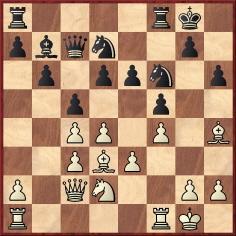
16 d5 exd5 17 Bxf5 Rae8 18 Rae1 Ne4 19 Bg6 Nxd2 20 Qxd2 Re6 21 f5 Re4 22 Rf4 Nf6 23 Bxf6 gxf6 24 cxd5 Rxf4 25 exf4 Rd8 26 c4 Bc8 27 Re3 Qg7 28 Qe1 Rf8 29 Re7 Qh8 30 Qg3 Resigns.
The Westbrock game was also on page 16 of the Brooklyn Daily Eagle, 2 April 1942:
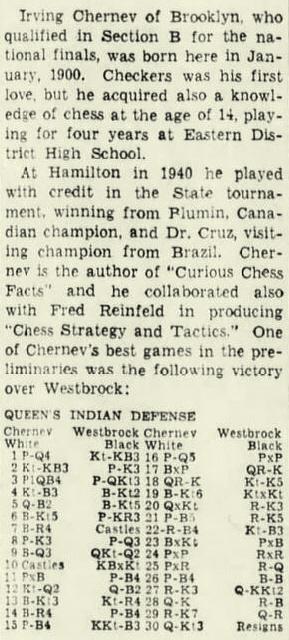
The Eagle was apparently mistaken about Chernev’s place of birth (‘here’). His date of birth was discussed in C.N. 3007 (see page 98 of Chess Facts and Fables).
The most detailed article about him is ‘An Invitation to Chernev’ by Jerome Tarshis on pages 500-503 of Chess Life & Review, September 1979. Some recollections quoted on page 501:
‘The writing that I did was done on weekends and after hours ... It was only when I had an idea that I thought merited a book that I would do a book, and then I would spend a lot of time on it. For example, when I wrote The 1000 Best Short Games of Chess, I went through some 15 to 20 thousand games, to pick out games that were dissimilar and weren’t just baby traps, or dreadful blunders in the opening.
When I wrote Logical Chess Move by Move – and this also applies to The Most Instructive Games of Chess Ever Played – I went through hundreds and hundreds of games that were mostly positional in character. I wanted to be able to point out that the positional play was more important, and that the combinations would come of themselves.
It wasn’t easy to choose the games. In a lot of fine games there are a great many moves that are not exactly meaningless but are difficult to explain to the average or below-average player. And it wasn’t enough for me to find a good game where the two bishops are better than the two knights. I wanted to find the very best example.’
(8814)
C.N.s 644 and 5036 quoted some comments to us about Reinfeld from Irving Chernev, in a letter dated 19 January 1977:
‘I thought I was the only one who saw that The Human Side of Chess was written with venom. But then, Reinfeld hated impartially! He hated Morphy, Alekhine and Capablanca most of all. He hated all chessplayers – except those who bought his books. Those he despised.’
C.N. 5036 reproduced the relevant section of Chernev’s letter to us:

C.N. 2841 reported that Chessville, a website of the time (January 2002), had attributed the above quotation to us, and refused to correct its mistake.
Below is part of C.N. 8652, which showed extracts from pages 12-13 of Combinations The Heart of Chess by I. Chernev (New York, 1960):
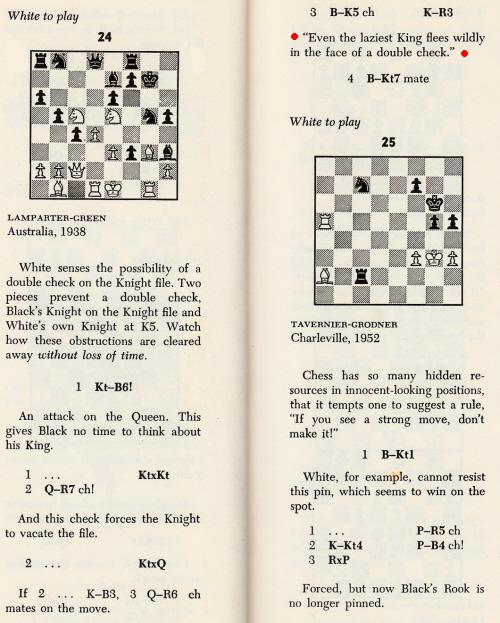
Concerning the note after 3...Kh6, it is unclear why Chernev did not mention that ‘Even the laziest king flees wildly in the face of a double check’ was a remark by Nimzowitsch. Chernev knew it, having given the attribution in an article on the inside front cover of Chess Review, November 1954:
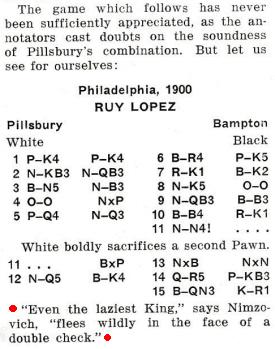
The full Pillsbury v Bampton feature was reproduced on pages 200-201 of Chernev’s book The Chess Companion (New York, 1968), and the position at move 13, when the black king flees from the threat of double check, may seem a better illustration than the Lamparter v Green position.
It will be seen that Chernev also wrote:
‘Chess has so many hidden resources in innocent-looking positions that it tempts one to suggest a rule, “If you see a strong move, don’t make it!”’
From our collection:

For an examination of Chernev’s reliability regarding stories about chessplayers, see Chess Anecdotes.
Gerard Killoran (Ilkley, England) notes that a century ago reports in the Brooklyn Daily Eagle referred to Isidore, not Irving, Chernev. One of several instances is on page 38 of the 15 October 1916 edition:

We see that page 3 of the Brooklyn Daily Eagle, 12 March 1913 had ‘Isidor Chernev’.
(8981)
Roger Mylward (Lower Heswall, England) writes:
‘I have examined the United States Federal Census for 1910 and 1920 covering the Brooklyn area of New York. In 1910 the following family members were living in Brooklyn Ward 16, Kings, New York: William Chernev (aged 34), Mollie Chernev (33), Isidor Chernev (10), Celia Chernev (8) and Rose Chernev (4). The family had emigrated from Russia in 1907; William was a retail merchant dealing in groceries.
In the 1920 Census, the family (living in Brooklyn Assembly District 6) consisted of William Chernev (aged 45), Irving Chernev (19), Celia Chernev (18), Rose Chernev (14) and Michael Chernev (8).
The 1915 New York State census had the forename Isidor. According to the New York Death Index, Mollie Chernev died, aged 42, on 18 October 1919 in King’s, New York.’
(8989)
‘One of the chess books of the century’ was discussed by C.J.S. Purdy on page 140 of Chess World, 1 June 1948. ‘We have searched for some fault so that our review should not be all praise, but we have searched in vain. No, we must congratulate the authors on a brilliant idea executed with meticulous attention to every detail.’
Purdy also wrote:
‘... the ordinary beginner’s book plunges into a slough of dull verbiage. But how can you explain chess without words?
Well, the miracle has been accomplished as far as is humanly possible in Invitation to Chess by Kenneth Harkness and Irving Chernev.’
The book, based on material which had appeared in Chess Review, was first published by Simon & Schuster, New York in 1945, and an advertisement on the inside front cover of the June-July 1945 Chess Review called it ‘the most revolutionary chess primer ever published’. The book’s early sales were reported in a full-page advertisement on page 9 of the November 1945 Chess Review. The relevant half of that page:
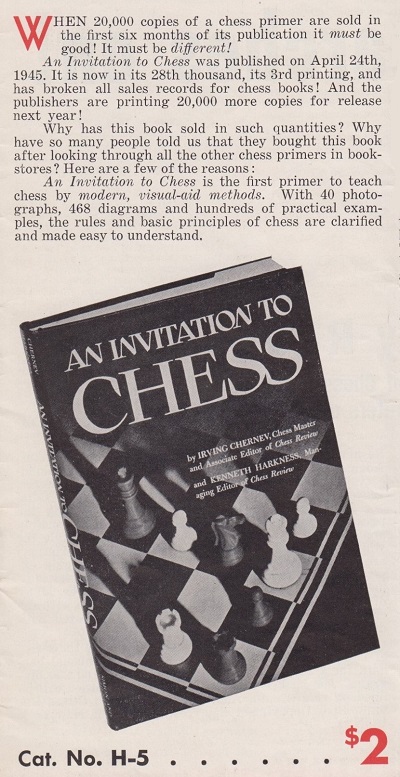
An Invitation to Chess was also published by Faber and Faber Limited, London in 1947.
(9212)
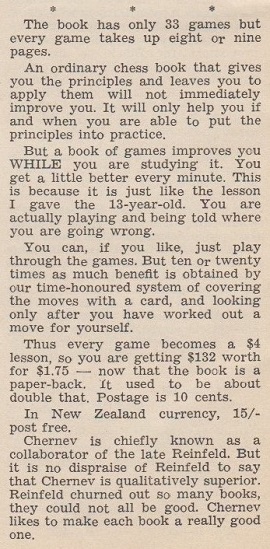
The above passage about Logical Chess Move by Move by Irving Chernev comes from page 80 of the March-April 1967 Chess World. It was omitted from page 65 of The Search for Chess Perfection II by C.J.S. Purdy (Davenport, 2006) and from page 147 of The Chess Gospel According to John edited by R.J. Tykodi and Bob Long (Davenport, 2010). In both books its place would have been just before the paragraph beginning ‘In this series ...’.
(9713)
From page 52 of the same issue (March-April 1967) of Chess World:
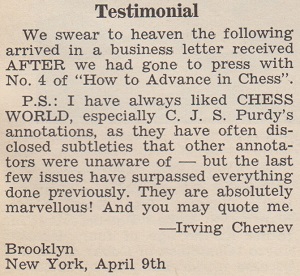
Purdy’s ‘How to Advance in Chess’ article was on pages 77 and 80 of the same issue. Most of his praise of Irving Chernev was quoted in C.N. 9713, but below is an additional passage in which Purdy related that he had recently given a chess lesson, lasting just over an hour, to a 13-year-old girl, ‘a fairly raw beginner’:
‘What would I charge for such a lesson normally? Well, at least $4, assuming I was willing to give one at all. Not many beginners care to pay so much for early lessons.
What is the answer? I saw it at once, and told the pupil, who realized I would not have time to give further lessons.
Ten years ago there was no answer. Now there is. It is Chernev’s Logical Chess Move by Move.
For this is the only book of annotated games that is comprehensible to a tyro. Every other book of annotated games leaves some moves unexplained.’
(11702)
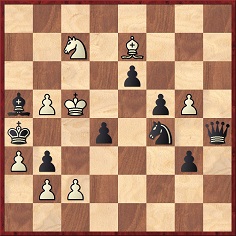
White to move
Page 173 of The Bright Side of Chess by Irving Chernev (Philadelphia, 1948):
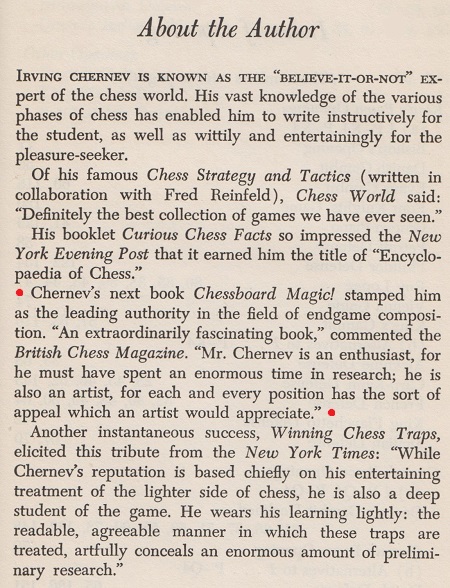
Chernev was certainly a leading popularizer of endgame compositions, and particularly with his 1943 book Chessboard Magic!
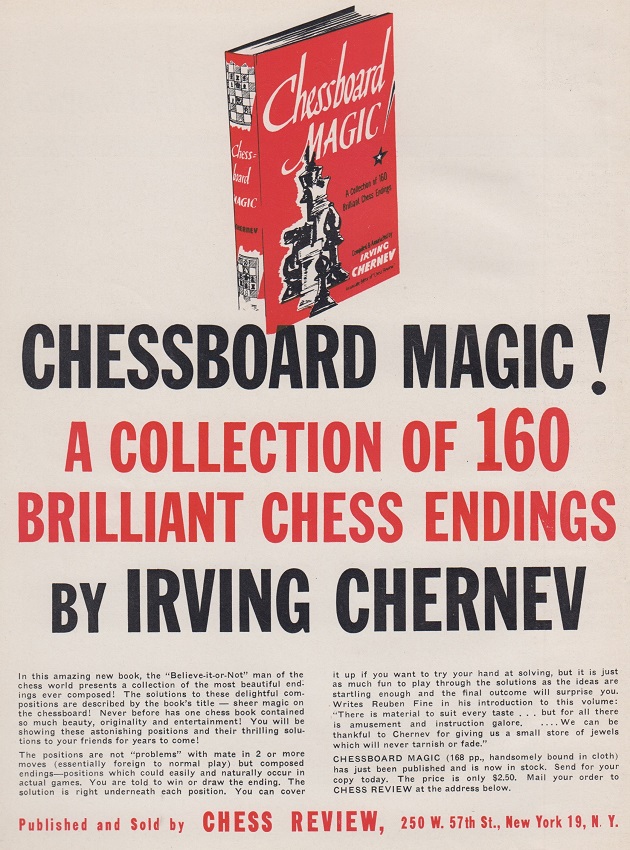
Chess Review, January 1944, inside front cover
In the Preface (pages ix-x) Chernev related Emanuel Lasker’s enthusiasm for studies:

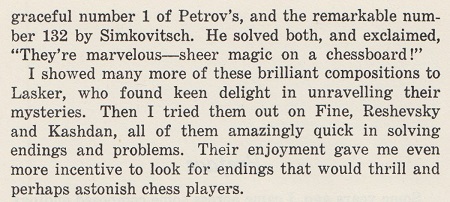
A few of the compositions in Chessboard Magic! were faulty, such as this one:
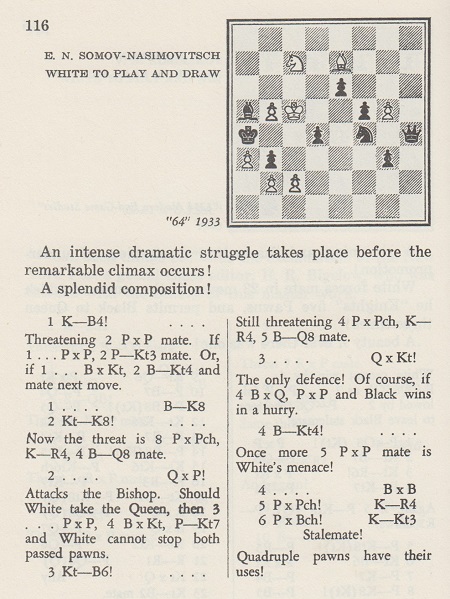
In the ‘Ask the Masters’ feature on page 284 of the May 1979 Chess Life & Review a reader, James Joyce of Missouri, wrote:
‘Didn’t the composer (Somore – Nasimotich [sic]) and the annotator (Irving Chernev) both miss a mate in five? 1 K-B4 B-K8 2 PxPch K-R4 3 N-R8 Q-R1 (or 3...N-Q4 4 B-Q8ch N-N3ch 5 BxN mate) 4 B-N4ch BxB 5 PxB mate.’
Pal Benko responded:
‘You are right that the mate is much stronger than the intended 1 K-B4 B-K8 2 N-K8 QxP 3 N-B6 QxN 4 B-N4 BxB 5 PxPch K-R4 6 PxBch K-N6 [sic] stalemate. I don’t feel sorry for this endgame. The setup is very superficial and there is too much material, so the “magic” part of it is unclear. But feel sorry for the composer, for it is impossible to make every endgame cookproof; so far the computer can verify only direct mates.’
We add that the unsoundness of this study by Evgeny Nikolaevich Somov-Nasimovich (1910-42) had already been demonstrated (with Na8 on move two) by G. Karoly of Melbourne on page 70 of Chess World, 1 March 1950:
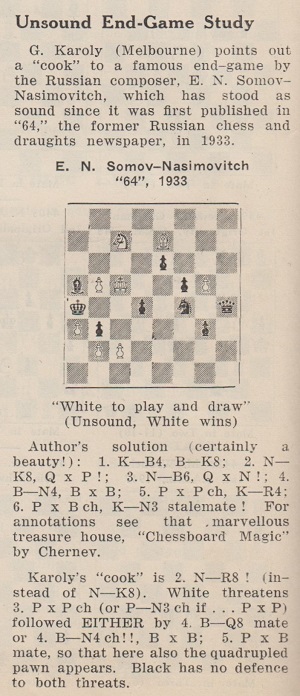
(10275)
‘Despite all the strictures against greed, nearly all players succumb to the temptation to grab first and think it over later.’
Source: page 22 of 1000 Best Short Games of Chess by Irving Chernev (New York, 1955).
(10906)
Page 324 of the November 1955 BCM had an assessment by D.J. Morgan of Chernev’s 1000 Best Short Games of Chess:
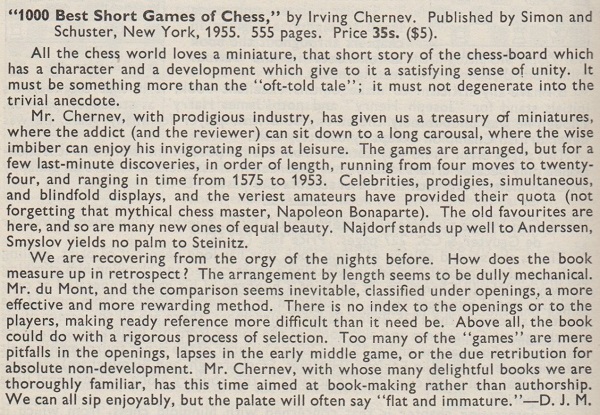
(11013)
A fairly extensive book list is being produced by The Fireside Chess Library. First a reprint: Irving Chernev’s The 1000 Best Short Games of Chess, a book which has incurred much criticism for its haphazard presentation and superficiality; on page 324 of the November 1955 BCM D.J. Morgan observed that Chernev ‘has this time aimed at book-making rather than authorship’. Seldom do the annotations inform the reader where the loser went wrong, but, as on most other occasions, Chernev’s charm and humour more or less enable him to get away with it. One advantage of the reprint is that it incorporates indexes of players and openings; these are invaluable since the games are arranged by length.
Both the Chernev work and pages 96-97 of Chess Traps, Pitfalls and Swindles by I.A. Horowitz and Fred Reinfeld (also reprinted by The Fireside Chess Library) give the following game (‘Amateur v Beis, Germany, 1940’, says Chernev): 1 e4 e5 2 f4 d5 3 Nf3 dxe4 4 Nxe5 Nc6 5 Bb5 Nf6 6 Nxc6 bxc6 7 Bxc6+ Bd7 8 Bxa8 Bg4 (‘Boom: There goes the Queen and the game’ – Chernev.) However, in Chess Life & Review, August 1978 (page 438), a reader, Don Reckseen, pointed out that White could keep going with 9 Bxe4 Bxd1 10 Bc6+, followed by 11 Kxd1. Confirming this, John Peters gave the line 9...Qe7 10 d3 and said that instead of 8 Bxa8 White could have achieved approximate equality with 8 Bxd7+ Qxd7 9 d3. (We note that page 8 of Falkbeer Counter-Gambit edited by Colin Leach (Caissa Books) says that the moves up to 8...Bg4 also occurred in a game Tartakower v Gruber, Vienna, 1919).
(1656)
Only one composition in Irving Chernev’s Chessboard Magic! (New York, 1943) was marked ‘Anonymous’:
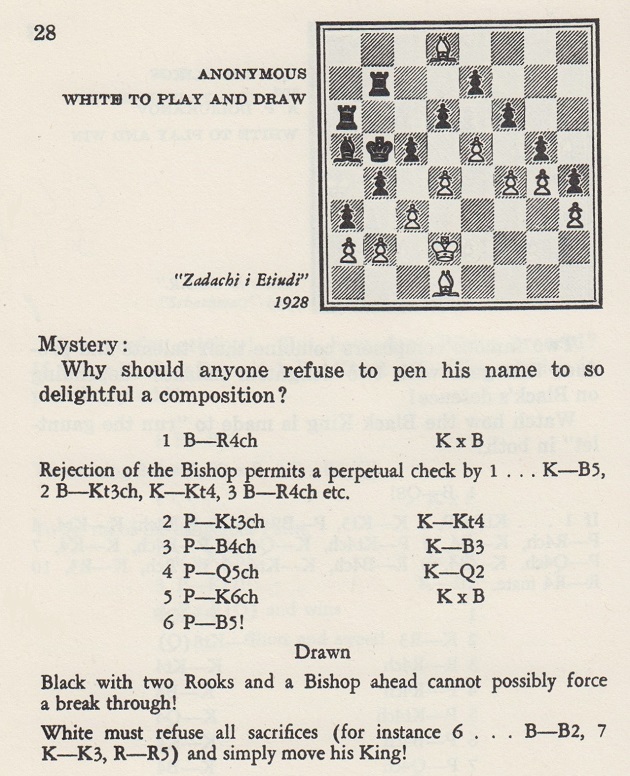
(11638)
For the remainder of that C.N. item and details about the composition, which was by William Edward Rudolph, see A Chess Fortress.
Concerning one chapter in Chernev’s book The Bright Side of Chess, see Muddled Chess Epigrams.
From page 399 of The Joys of Chess by Christian Hesse (Alkmaar, 2011):
‘All in all Akiba Rubinstein played 1985 tournament games in his life, of which 1763 had rook endgames.’
The book’s author/compiler does not believe in using primary sources or in specifying his secondary sources for particular items (many positions and other material are taken from Chess Notes, in exchange for a one-line mention of our website in a list on page 427). Since The Joys of Chess gives no source for the Rubinstein statistics, we shall do so. The sentence was written by Irving Chernev on the inside front cover of the July 1952 Chess Review, was reproduced on page 270 of his book The Chess Companion (New York, 1968) and was an obvious joke.
(7083)
See also Falkbeer, Staunton and Löwenthal.
To the Chess Notes main page.
To the Archives for other feature articles.
Copyright: Edward Winter. All rights reserved.